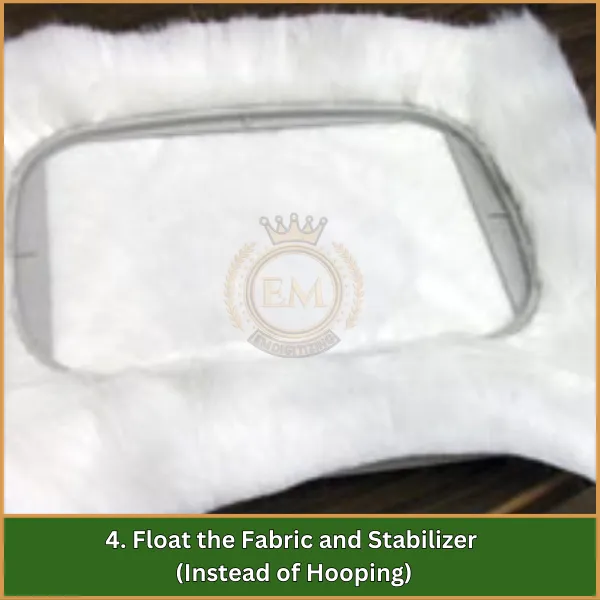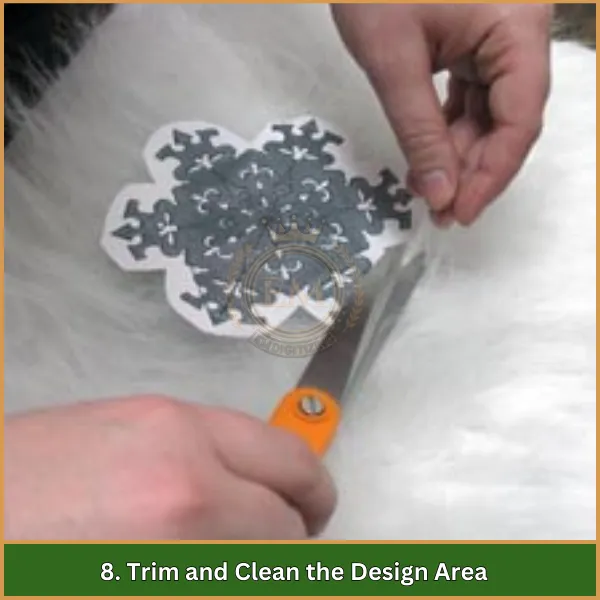Comment broder sur de la fausse fourrure peut sembler délicat au début, mais avec les bons conseils, vous pouvez créer de superbes designs même sur des surfaces moelleuses! La fausse fourrure est unique en raison de sa texture, qui cache souvent de petits détails, donc faire ressortir la broderie nécessite quelques techniques spéciales.
Dans ce guide, Je vais vous guider à travers des étapes simples et des conseils incontournables pour donner à votre broderie en fausse fourrure un aspect professionnel et soigné.. Que vous débutiez dans la fausse fourrure ou que vous cherchiez à améliorer vos compétences, ces méthodes simples vous aideront à créer des designs qui ont fière allure, reste à l'écart, et j'ai ce facteur wow.
Plongeons dedans!

Comment broder sur du tissu en fausse fourrure comme un pro?
Matériaux essentiels pour broder sur de la fausse fourrure
Pour obtenir les meilleurs résultats sur la fausse fourrure, utiliser les bons matériaux est essentiel. Here’;est une liste d'éléments qui vous aideront à créer des, broderie professionnelle sur ce tissu unique.
- Tissu en fausse fourrure
- Machine à broder
- Aiguilles à broder (pointu ou à bille)
- Fil à broder (polyester ou rayonne)
- Stabilisateur (coupe ou déchirement)
- Adhésif en spray temporaire
- Ciseaux (pour couper la fourrure et les fils)
- Outil de marquage (soluble dans l'eau ou effaçable à la chaleur)
- Cerceau de broderie
1. Tissu en fausse fourrure

Le tissu en fausse fourrure est le principal matériau qui nécessite une manipulation et une préparation spéciales pour la broderie.. Il en existe de différents types, y compris court, moyen, et poils longs.
La fausse fourrure à poils ras est généralement recommandée pour la broderie car elle offre une surface plus stable, rendant les détails du design plus visibles et le processus de broderie plus facile. Choisir le bon type de fausse fourrure est essentiel pour éviter les peluches excessives qui peuvent obscurcir le motif..
2. Machine à broder
Une machine à broder est indispensable pour une broderie précise et professionnelle sur tissu fausse fourrure. Une machine avec tension réglable et diverses options de points est idéale pour travailler sur des tissus épais comme la fausse fourrure, car il permet plus de personnalisation et garantit un fonctionnement fluide, même des coutures.
3. Aiguilles à broder
L’utilisation du bon type d’aiguille est cruciale pour broderie en fausse fourrure. Les aiguilles pointues sont recommandées car elles percent le tissu épais en douceur sans endommager les fibres.. Les aiguilles à bille sont également une option pour la fausse fourrure avec un support en tissu, car ils glissent entre les fibres sans couper.
4. Fil à broder
Les fils de polyester ou de rayonne conviennent mieux à la fausse fourrure car ils sont solides et résistants à la décoloration., même sur des surfaces texturées. Fil de polyester, en particulier, est recommandé pour la durabilité et l’éclat des couleurs, s'assurer que le design se démarque sur les tissus somptueux comme la fausse fourrure.
5. Stabilisateur
Un stabilisateur est essentiel pour maintenir la fausse fourrure en place et empêcher le tissu de bouger. Le stabilisateur Cutaway est recommandé pour les fausses fourrures plus épaisses car il offre un soutien ferme.. Un stabilisateur détachable peut également être utilisé si la fausse fourrure est légère et ne nécessite pas autant de stabilité..
6. Adhésif en spray temporaire
L'adhésif en spray temporaire aide à maintenir l'entoilage et le tissu en fausse fourrure bien en place pendant la broderie.. Cela empêche le déplacement, ce qui est commun avec la texture moelleuse de la fausse fourrure, s'assurer que la conception reste alignée tout au long du processus.
7. Ciseaux
Des ciseaux à broder pointus sont essentiels pour couper la fourrure et le fil sans tirer ni endommager le tissu.. Plus petit, des ciseaux précis sont particulièrement utiles pour découper autour du motif, donner une finition épurée à la fausse fourrure brodée.
8. Outil de marquage
Un outil de marquage soluble dans l'eau ou effaçable à la chaleur est idéal pour marquer des lignes directrices sur du tissu en fausse fourrure.. Ces marquages facilitent le placement précis du motif et peuvent être facilement retirés après la broderie., s'assurer qu'aucun résidu n'est laissé sur le tissu.
9. Cerceau de broderie
Un cercle à broder est essentiel pour maintenir fermement le tissu en fausse fourrure en place., permettant une couture précise. Choisissez une taille de cerceau qui correspond à votre conception pour éviter tout déplacement, car le cerclage aide à contrôler le caractère pelucheux de la fausse fourrure et l'empêche d'interférer avec la broderie.
Comment broder sur de la fausse fourrure: Guide étape par étape
La broderie sur fausse fourrure nécessite des techniques spécifiques pour obtenir un résultat professionnel. Suivez ces étapes pour vous assurer que votre broderie machine sur fausse fourrure est propre et bien définie..
1. Préparez le tissu en fausse fourrure

Avant de commencer, préparez la fausse fourrure en coupant tout excès de peluches de la zone où vous allez broder. Cette étape est essentielle si vous travaillez avec de la fausse fourrure à poils longs, car cela peut masquer les détails de conception.
2. Choisissez et sécurisez le stabilisateur

Fixez un stabilisateur découpé ou déchirable à l'arrière du tissu en fausse fourrure.. Utilisez un adhésif en spray temporaire pour le maintenir en place, garantissant que le tissu reste stable tout au long du processus de broderie.
3. Marquez la zone de broderie

Utilisation d'un outil de marquage soluble dans l'eau ou effaçable à la chaleur, marquez le centre de votre motif sur la fausse fourrure. Ce marquage aidera à placer le motif avec précision sur le tissu..
4. Faites flotter le tissu et le stabilisateur (Au lieu de cerceau)

Pour la fausse fourrure, le flottement du tissu est souvent préféré au cerclage. Placez la fausse fourrure stabilisée sur l'entoilage encerclé sans la fixer directement dans l'arceau. Le flottement aide à prévenir l'aplatissement de la fourrure et réduit les brûlures du cerceau., ce qui peut laisser des traces sur le tissu.
5. Numérisez le motif de broderie pour la fausse fourrure

Savoir broder avec succès sur de la fausse fourrure commence par une bonne numérisation. Modèles avec plus grand, des formes plus audacieuses et une densité de points plus faible fonctionnent mieux, car ils ressortent plus clairement sur la texture moelleuse de la fausse fourrure.
Si vous n’avez pas de design numérisé prêt, vous pouvez le numériser de manière experte via EMnumérisation. Nous offrons services de numérisation de haute qualité à des tarifs abordables, garantir les meilleurs résultats pour la broderie en fausse fourrure, avec chaque conception optimisée pour la clarté et le professionnalisme.
6. Charger et configurer la machine à broder

Une fois votre conception numérisée, chargez-le dans la machine à broder pour broder efficacement sur de la fausse fourrure. Assurez-vous que les réglages correspondent à l’épaisseur de la fausse fourrure et réglez la vitesse sur une vitesse plus lente si possible, car la fausse fourrure nécessite des coutures plus contrôlées pour garder le design aligné et précis.
7. Commencez le processus de broderie

Commencez à broder le motif, surveiller attentivement le processus. La fausse fourrure peut nécessiter de légers ajustements ou des pauses pour garantir que le tissu reste aligné et que les points restent clairs et définis..
8. Découper et nettoyer la zone de conception

Une fois la broderie terminée, coupez tous les fils parasites et peluchez la fourrure autour du motif pour restaurer sa texture. Attention à ne pas tirer trop fort, car cela pourrait endommager la broderie ou le tissu.
9. Retirez les marquages et le stabilisateur

Pour terminer, retirez tout stabilisateur restant de l’envers du tissu. Si vous avez utilisé un outil de marquage soluble dans l'eau, nettoyer délicatement les marquages avec un chiffon humide, s'assurer qu'aucun résidu n'est laissé sur le tissu.
Conseils pour numériser des motifs de broderie pour la fausse fourrure
- Choisissez gras, Conceptions simples: Évitez les détails complexes; les formes audacieuses ressortent mieux sur la fausse fourrure.
- Densité de point inférieure: Réduit le matage et maintient le motif visible sur la surface du tissu.
- Augmenter la compensation de traction: Empêche la distorsion du design sur la fausse fourrure en ajustant le déplacement du tissu.
- Utiliser des points satin pour les contours: Crée du gras, lignes visibles; évitez les points fins ou coulants.
- Évitez les petits caractères: Utilisez un grand, polices simples pour plus de lisibilité; un petit texte peut se perdre dans la fourrure.
- Test sur un échantillon de tissu: Exécutez un point de test pour vérifier l’apparence du motif et effectuer des ajustements.
- Option de numérisation professionnelle: Bénéficiez de numérisations expertes de notre part pour des résultats de haute qualité sur la fausse fourrure.
Conclusion
Comment broder sur de la fausse fourrure peut être une expérience amusante et enrichissante lorsque l'on connaît les bonnes techniques. En suivant les étapes et conseils de ce guide, vous pourrez créer des designs qui se démarquent vraiment sur des tissus moelleux. Une numérisation appropriée est essentielle pour la broderie en fausse fourrure afin de garantir que votre motif semble clair et professionnel..
Si vous avez besoin d'aide pour numériser, EMnumérisation offre des services de premier ordre aux tarifs les plus abordables, avec un délai d'exécution ultra-rapide et une qualité garantie. Plus, nous proposons une option de prévisualisation afin que vous puissiez voir votre conception avant de la finaliser.
Et si vous êtes un premier client, profitez d'un spécial 50% remise sur votre commande. Laissez-nous vous aider à donner vie à votre broderie en fausse fourrure avec expert en numérisation!
